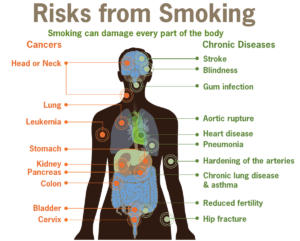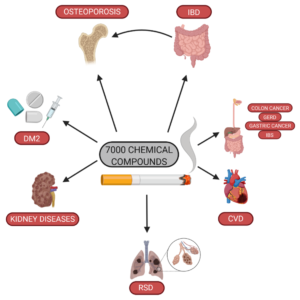Smoking is often associated with cardiovascular and lung diseases, but its profound influence on musculoskeletal health, including bone health, is less well-known. This article sheds light on the intricate connection between smoking and the health of your bones and joints.
How Smoking Affects Bones
Cigarette smoking is strongly linked to osteoporosis, a condition characterized by weakened and brittle bones. Tobacco smoke exerts a multifaceted influence on bone health. It disrupts calcium absorption, interferes with vitamin D levels, disrupts hormonal balance, and impedes blood circulation. Moreover, it hampers both the reabsorption and formation of new bone, leading to elevated oxidative stress. Collectively, these factors gradually raise the risk of osteoporosis in smokers. They face a 25% higher risk of fractures and a 50% higher risk of hip fractures compared to non-smokers. Furthermore, smokers may experience complications such as delayed bone healing after fractures and surgeries.
Impact on Bone Density
The chemicals in cigarettes, particularly nicotine, hinder the body’s ability to absorb calcium from the diet, resulting in lower bone mineral density. Calcium is crucial for bone mineralization, and reduced absorption in smokers leads to fragile bones. Studies have indicated that both men and women who smoke for extended periods are at risk of osteopenia or osteoporosis, lower back pain, decreased estrogen levels, and reduced cortical thickness, particularly in young men.
Risks of Rheumatoid Arthritis
Smoking doesn’t spare the joints and cartilages. It also affects blood supply to bones and other parts of the body, contributing to joint pain and autoimmune diseases. Research conducted by the American Academy of Orthopedic Surgeons reveals that smokers face an increased risk of inflammatory conditions like rheumatoid arthritis and systemic lupus erythematosus (SLE). Even mild smoking escalates the risk of developing rheumatoid arthritis in individuals with a genetic predisposition to autoimmune diseases. Furthermore, regular smoking intensifies the chances of autoimmune diseases and several cancers, making treatment challenging.
Soft Tissue Injuries and Fractures
Smoking has adverse effects on bone-forming cells (osteoblasts) and other musculoskeletal tissues, making smokers more susceptible to soft tissue injuries, sprains, fractures, and back pain than non-smokers. Notably, rotator cuff tears and overuse injuries such as bursitis and tendonitis are prevalent among smokers. Reduced blood circulation in smokers leads to slow healing of these injuries and an increased risk of reinjury. Research suggests that 30-40% of older smokers are prone to hip fractures due to minor falls.
Body Weight and Athletic Performance
Smoking tends to lower body mass index (BMI) and lead to a thin skeletal frame. This is partly due to impaired nutrient absorption and nicotine-induced appetite suppression. Low BMI and thin skeletal frames increase the risk of osteoporosis and fractures. Furthermore, smoking can hinder athletic performance by compromising lung function and blood circulation, resulting in fatigue and difficulty in physical activities.
Passive Smoking’s Impact on Bone Health
Not only active smoking but passive smoking, or exposure to secondhand smoke, can have detrimental effects. Research shows that exposure to tobacco smoke can increase the risk of various conditions, including impaired bone health. Children exposed to secondhand smoke during their formative years are at a higher risk of developing osteoporosis in adulthood. Studies on growing rats demonstrate that prolonged exposure to tobacco smoke directly alters bone density and interferes with bone development. In essence, passive smoking is equally harmful as active smoking.

Effective Smoking Cessation
Quitting smoking can reverse the risk of fractures to some extent. While it’s challenging, there are effective strategies to quit smoking:
- Set a Quit Date: Choose a specific date to quit and commit to it.
- Manage Urges and Triggers: Control smoking triggers by substituting cigarettes with healthy alternatives like water, beverages, gum, or snacks.
- Consider Nicotine Replacement Therapy: This is recommended for long-term smokers with severe withdrawal symptoms.
- Practice Deep Breathing and Meditation: These techniques can help manage stress and mood swings during the withdrawal process.
- Seek Behavioral Support: Professional support and counseling, along with pharmacotherapy, can enhance the success of quitting smoking.
Incorporating these measures can help you quit smoking and embark on a healthier path for your musculoskeletal health. Outdoor exercise, especially in the morning, can further promote fitness, relieve pain and stress, and support the healing process of bones and soft tissues.
Smoking is a habit that has been linked to numerous health problems, including those affecting the musculoskeletal system. The musculoskeletal system includes the bones, muscles, tendons, ligaments, and joints, all of which play a crucial role in our mobility and overall well-being.
SOME FAQ!!
Q. How does smoking affect my bone health?
Answer. Explore the various ways in which smoking influences bone health, including its impact on bone density and the development of osteoporosis.
Q. Can smoking lead to joint problems?
Answer. Learn about the connection between smoking and joint health, including the risks of developing conditions like rheumatoid arthritis and joint pains.
Q. What are the risks of passive smoking on musculoskeletal health?
Answer. Discover the effects of secondhand smoke exposure on bones and joints, especially in non-smokers and children.
Q. Is there a link between smoking and fractures?
Answer. Find out how smoking increases the risk of fractures, as well as its implications for bone healing and post-fracture complications.
Q. How can I quit smoking and improve my musculoskeletal health?
Answer. Learn effective strategies and tips for quitting smoking and enhancing your overall musculoskeletal well-being.
Q. Are there any lifestyle changes that can help mitigate the effects of smoking on bones and joints?
Answer. Explore lifestyle adjustments that can complement smoking cessation efforts and promote better musculoskeletal health.
Note: All images used in this blog credits belong to their respective owners















Jenifer.S
July 8, 2024I like this blog it's a master piece! Glad I detected this ohttps://69v.topn google.Raise blog range